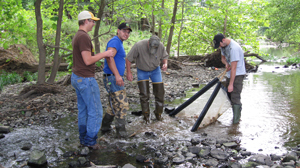Stream Teams on the Job!

The Blue Thumb water pollution education program recently recognized a group of Blue Thumb volunteers for the work they do monitoring 29 stream sites. The individuals were recognized for their dedication and consistency on the streams they monitor out of the more than 100 streams actively monitored in the program.
“This group of volunteers has worked hard to complete their stream monitoring on a monthly basis during 2010,” said Cheryl Cheadle, Blue Thumb Program coordinator. “That means they were outdoors in all kinds of weather making stream observations, collecting water samples and running a battery of tests,” she said.
Cheadle added that in some seasons, the volunteers also venture out to make biological collections. Stream insects and other benthic macroinvertebrates are collected in the winter and the spring, and streamflow is measured as well. Fish collections are rotated with regard to ecoregion and take place about every four years. Volunteer efforts are critical in all aspects of Blue Thumb stream monitoring.
A review of volunteer-collected data for 2010 revealed that volunteers working on the following streams went an extra mile to keep their monitoring current, according to Cheadle.
- Beaver County: Sharps Creek
- Blaine County: Minnehaha
- Cherokee County: Baron Fork / Cedar Hollow / Park Hill Branch / Spring Creek / Flint Creek
- Comanche County: East Cache Creek / Medicine Creek
- Creek County: Little Polecat
- Delaware County: Whitewater Creek
- Latimer County: Bandy Creek / Fourche Maline
- LeFlore County: Mountain Creek / Polk Creek / Black Fork of the Poteau / Caston
- Creek Little Mountain Creek / Poteau River / Woods Creek
- McClain County: Walnut Creek Tributary
- Murray County: Rock Creek
- Noble County: Doe Creek
- Oklahoma County: Coffee Creek / Crutcho Creek
- Osage County: Bigheart Creek / Delaware Creek
- Payne County: Stillwater Creek
- Pontotoc County: Little Sandy Creek
- Tulsa County: Nickel Creek
The result of those efforts is a wealth of information on the health and conditions of the streams, Cheadle said.
“Almost every Oklahoman wants to know how the creek in their neighborhood is faring, and having a corps of caring, well-trained volunteers lets us know just how well many of our streams and rivers are doing,” Cheadle said. Often, volunteer-generated data is the only data that exists for some of the streams, she said.
“Probably the most important aspect of our Blue Thumb Program is the work done by our volunteers to help local residents understand that streams and rivers are best protected when the public knows how to be good stewards of our natural world. Being careful what we apply to our yards, keeping our cars and trucks in good shape so that oil leaks don’t make their way into streams, and picking up after pets are just a few ways to
help streams,” Cheadle summarized.
For more information about Blue Thumb, call 918-398-1804 or go to www.conservation.ok.gov and click Blue Thumb in the top left corner.
